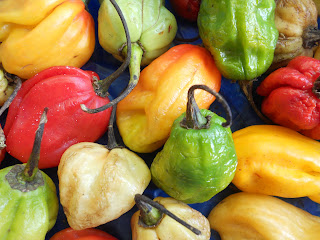Ingredient of the Month 8 : Chillis
 |
| L: Homegrown Nag Bhuta (Bhut Jolokia) chillis from our freezer. R: Scotch Bonnet chillis, also very hot! |
Remember back in January, when I wrote about Food Trends for 2012? One of the things I wrote was that chilli knowhow would be big, so here's some information (mainly gleaned from my good friend Wikipedia) which I hope will be both interesting and useful:
- Chillis originate from South America, and spread via European traders to Africa, the far East and South Asia.
- They belong to the solanaceae, or deadly nightshade family, which also includes potatoes, tomatoes and aubergine (aka eggplant).
- As chillis are not native to India and were unknown there until a few hundred years ago, Vaisnavas do not generally use them very much in cooking, and at the Jagannatha Mandir in Puri the Lord is never offered foodstuffs such as tomatoes, chillies, peppers or aubergine.
- The "heat" of chillis comes from capsaicin and related chemicals called capsaicinoids. They react with pain receptors in the mouth to create the distinctive sensation of heat that characterises chilli.
- Green chilli peppers are essentially unripe red chilli peppers.
- There are many types of chilli: bell peppers (not hot at all), cayenne, tabasco, piri piri, bird's eye, naga, habanero, jalapeno, Scotch bonnet, poblano, serrano, to name but a few.
- Chilli heat is measured in units called Scovilles ( abbreviated to SHU). Originally the heat was measured by how much chilli extract needed to be diluted in sugar before it became edible. Nowadays quantative analysis by liquid chromatography of the capsaicin is used to measure the SHU.
- The hottest chillis in the world (as of February 2012) are:
- Trinidad Moruga Butch T Scorpion
- Trinidad Scorpion
- Infinity
- Naga Viper (grown in Cumbria, England!)
- 7 Pods
- Bhut Jolokia (aka Naga Bhut)
- There are too many dishes from around the world featuring chillis to mention here. The Maya people of Mexico and Guatemala used to flavour their chocolate drink with chillis; a combination which enjoyed a brief revival here in the UK for a couple of years. Cooking with chillis is common in Hungary, Spain, parts of Italy (putanesca sauce), Africa, India and the far East.
- Chillis are good sources of Vitamin C, iron and other minerals, but you probably wouldn't eat enough to get much benefit.
- Chillis also have great medicinal properties: capsaicin is used as a topical analgesic for arthritis and herpes zoster (shingles). It can also relieve headaches; I can vouch for this myself- I have managed to nip a headache in the bud before now by eating a small amount of raw chilli. Recent findings also suggest that chillis may have anti-bacterial, anti-diabetic and anti-carcinogenic properties as well as reducing LDL chloresterol levels.
.... but do watch out if you suffer from gastro-oesophagal reflux, as chills can irritate this. Yoghurt and milk can ease the pain and irritation both internally and externally from too much chilli. As with most things in this life, moderation is the key!



Comments
Post a Comment
You are welcome to comment- feedback from you really helps me to decide what to post, and I love hearing from you- thanks :)